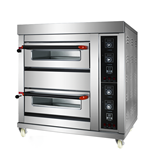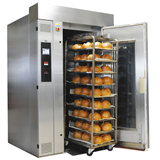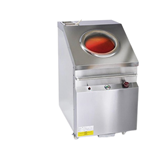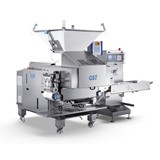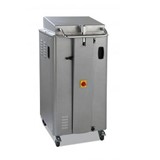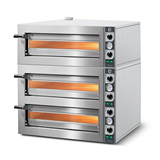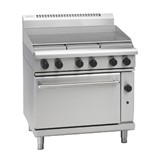In the dynamic landscape of commercial kitchens, efficiency and versatility are the driving forces behind culinary success. Enter the commercial electric combi oven—a culinary powerhouse that seamlessly combines the functionalities of convection ovens and steamers into one compact and innovative appliance. As establishments seek to optimize their cooking processes, investing in the right electric combi oven becomes a critical decision. This comprehensive buying guide aims to equip you with the knowledge and insights needed to make an informed choice when selecting the perfect commercial electric combi oven for your kitchen.
The guide will delve into key aspects of buying a commercial combi oven, empowering you to explore the appliance's versatility, size and capacity considerations, electric power requirements and efficiency, steam generation and control features, programmable functions and cooking modes, and the importance of comparing different brands and models. Additionally, you'll gain valuable insights into budget planning and financing options to make a well-informed investment.
By the end of this comprehensive buying guide, you will be equipped with the essential knowledge to confidently select a commercial electric combi oven that aligns with your kitchen's unique needs, culinary vision, and financial goals. So, let's embark on this culinary journey together as we explore the world of commercial electric combi ovens.
1. Understanding the Versatility of Combi Ovens
An electric combi oven is an ingenious appliance that offers unmatched versatility, making it a staple in commercial kitchens worldwide. This oven brings together the benefits of convection cooking and steam heating, enabling chefs to explore a wide range of cooking techniques and achieve precise culinary results.
Key points to understand about the versatility of combi ovens include:
- Combination Cooking: The electric combi oven combines dry heat from the convection element with moist heat from the steam generator. Chefs can use it for various cooking methods, including roasting, baking, steaming, poaching, grilling, and even smoking.
- Preservation of Nutrients and Flavors: The introduction of steam during cooking helps retain the natural moisture and nutrients in food, enhancing the flavors and preventing drying out.
- Cooking with Precision: Combi ovens often come with precise controls for humidity and temperature, allowing chefs to maintain the ideal cooking environment for different dishes.
- Reheating and Holding: The combi oven excels at reheating pre-cooked items while preserving their texture and quality. It can also hold food at a specific temperature before serving, streamlining kitchen operations during busy periods.
- Reduced Workload and Footprint: With the combi oven's ability to perform multiple cooking functions, it can replace several individual appliances, saving valuable kitchen space and reducing the workload on kitchen staff.
Understanding the versatility of electric combi ovens allows chefs and kitchen operators to explore diverse cooking techniques and enhance the culinary offerings of their establishments.
2. Size and Capacity Considerations
Selecting the appropriate size and capacity of an electric combi oven is essential to ensure seamless operations and efficient space utilization. Assessing your kitchen's cooking volume and available space will guide your decision-making process.
Key considerations for size and capacity include:
- Cooking Volume: Estimate the quantity of food you need to prepare daily to find the right oven capacity. Consider the busiest times in your kitchen and plan for the oven's ability to handle peak demand.
- Number of Racks: Assess the number of racks required for efficient cooking and multitasking. Multiple racks allow for simultaneous cooking of different dishes, increasing productivity.
- Available Space: Measure the available space in your kitchen to determine the dimensions that will fit best. Ensure there is enough clearance around the oven for proper ventilation and ease of use.
- Kitchen Workflow: Analyze your kitchen's workflow to position the electric combi oven optimally. Consider the flow of ingredients from prep stations to cooking and serving areas.
- Door Options: Evaluate the impact of different door types on space efficiency and ease of use. Swing doors require additional clearance in front, while lift-up doors or drop-down doors may be more space-saving.
- Choosing the right size and capacity ensures that the electric combi oven seamlessly integrates into your kitchen setup, maximizing productivity and minimizing operational bottlenecks.
3. Electric Power Requirements and Efficiency
Electric combi ovens rely on electricity as their primary power source. Understanding their electric power requirements and efficiency will help you manage energy consumption and operating costs effectively.
Key considerations for electric power requirements and efficiency include:
- Power Capacity: Determine the electric power capacity of your kitchen to ensure it can accommodate the oven's electrical needs. If your kitchen has limited power capacity, consider energy-efficient models.
- Energy Efficiency Features: Look for electric combi ovens with energy-efficient features, such as programmable settings, power-saving modes, and intelligent sensors that adjust energy consumption based on the cooking load.
- Insulation and Sealing: Quality insulation and a well-sealed oven door are essential to prevent heat loss and maximize energy efficiency. Optimal insulation ensures that the oven retains heat, requiring less energy to maintain the desired cooking temperature.
- Cooking Time Reduction: The efficient combination of convection and steam cooking in electric combi ovens reduces cooking time, leading to energy savings.
- Smart Controls: Some advanced electric combi ovens are equipped with smart controls that provide real-time energy usage data, allowing kitchen operators to monitor and optimize energy consumption.
By prioritizing electric power requirements and efficiency, you can make an environmentally-friendly choice that aligns with your kitchen's sustainability goals while minimizing operational costs.
4. Steam Generation and Control Features
Steam is a crucial component of combi ovens, and understanding its generation and control features is essential for achieving precise cooking results and preserving food quality.
Key steam generation and control features to consider include:
- Integrated Boiler vs. External Boiler: Some electric combi ovens come with an integrated boiler that generates steam within the oven itself, while others require an external boiler to supply steam. Integrated boilers offer more convenience and reduce maintenance needs.
- Steam Injection and Venting: Evaluate the efficiency and effectiveness of steam injection and venting systems. Consistent and precise steam generation is vital for achieving uniform cooking results.
- Humidity Control: Look for combi ovens with humidity control features that allow you to adjust the level of moisture during cooking. This flexibility is crucial for various cooking techniques.
- Automatic Cleaning Programs: Some electric combi ovens have automated cleaning programs that simplify the descaling and cleaning of the steam generator, ensuring its efficient operation over time.
- Water Quality Requirements: Consider the water quality needed for steam generation. Hard water may lead to scale buildup, affecting the oven's performance and longevity.
By understanding and leveraging the steam generation and control features, chefs can optimize the cooking environment and deliver outstanding culinary creations.
5. Programmable Functions and Cooking Modes
Modern electric combi ovens often come equipped with programmable functions and cooking modes that provide unparalleled precision and convenience in the kitchen.
Key programmable functions and cooking modes to explore include:
- Recipe Storage: Some combi ovens allow users to store and recall custom cooking recipes, ensuring consistent results and minimizing the need for manual adjustments.
- Multi-Step Cooking: Look for ovens with multi-step cooking capabilities that automatically adjust cooking parameters during the cooking process, optimizing flavor and texture.
- Temperature and Humidity Control: Precise temperature and humidity control are vital for achieving the desired results in different dishes, from crispy bread to succulent roasts.
- Core Temperature Probes: Electric combi ovens with integrated core temperature probes ensure that meats and poultry are cooked to perfection, eliminating the guesswork.
- Proofing and Fermentation: Some ovens offer dedicated proofing and fermentation modes for baking and dough preparation.
- Automated Cleaning Programs: Consider ovens with automated cleaning programs that simplify maintenance and ensure the oven's longevity.
By embracing the programmable functions and cooking modes of electric combi ovens, chefs can streamline operations and achieve consistent and delectable culinary outcomes.
6. Comparing Different Brands and Models
In the competitive market of electric combi ovens, various brands and models vie for your attention. Thoroughly researching and comparing different options will help you find a reputable and high-performing oven that meets your kitchen's specific requirements.
Key points to consider when comparing brands and models include:
- Reputation and Reviews: Look for well-established brands with a solid reputation for manufacturing quality electric combi ovens. Research customer reviews and feedback to gauge user satisfaction.
- Durability and Build Quality: Evaluate the construction and materials used in the oven's manufacturing. A robust build ensures long-term reliability and endurance in a demanding commercial kitchen environment.
- Warranty and Support: Examine the warranty coverage and available customer support. A comprehensive warranty provides peace of mind and assistance in case of unexpected issues.
- Price and Value: Balance the features and performance against the cost to find the best value. A higher initial investment may be justified if the oven offers superior efficiency, durability, and versatility.
- Certifications and Compliance: Ensure that the oven meets relevant safety and industry standards. Certifications like NSF (National Sanitation Foundation) indicate compliance with health and safety regulations.
While comparing brands and models, focus on finding an oven that aligns with your budget, cooking needs, and long-term goals for your commercial kitchen.
7. Budgeting and Financing Options for Purchase
Budget planning is a crucial step in purchasing a commercial electric combi oven. Understanding your financial capacity and exploring financing options can facilitate a smoother acquisition process.
Key considerations for budgeting and financing include:
- Setting a Realistic Budget: Determine a budget that aligns with your kitchen's needs and financial capacity. Consider the overall kitchen equipment budget, factoring in other essential appliances.
- Leasing vs. Buying: Assess the pros and cons of leasing versus outright purchase based on your business's financial goals. Leasing may allow you to acquire a high-quality oven without a substantial upfront investment.
- Financing Programs: Research financing programs offered by manufacturers or third-party vendors. These programs may provide favorable interest rates and flexible repayment terms.
- Total Cost of Ownership: Consider long-term operational and maintenance costs in addition to the initial purchase price. An oven with higher energy efficiency may result in lower operating costs over its lifespan.
- Return on Investment: Evaluate the potential return on investment based on improved efficiency, productivity, and the ability to expand your menu with specialized features.
Budget planning and exploring financing options help you make a well-informed decision, ensuring that the chosen electric combi oven aligns with your financial goals and operational requirements.
Conclusion
Congratulations! You have now reached the end of our detailed buying guide for commercial electric combi ovens. We hope this comprehensive exploration has shed light on the various aspects you need to consider when selecting the perfect combi oven for your commercial kitchen.
Understanding the versatility of commercial combi ovens and their ability to combine convection and steam cooking methods opens up a world of culinary possibilities. Assessing the size and capacity of the oven ensures seamless kitchen operations, while prioritizing electric power requirements and efficiency helps you make an environmentally-friendly choice that aligns with your kitchen's sustainability goals.
Exploring steam generation and control features enables you to achieve precise cooking results, while embracing programmable functions and cooking modes enhances kitchen productivity and consistency in culinary outcomes. Comparing different brands and models allows you to find a reputable and high-performing oven that meets your kitchen's specific requirements, while strategic budget planning and financing options ensure that your investment aligns with your financial goals.
Armed with this knowledge, you are now ready to make an informed decision and embark on a culinary journey filled with innovation, efficiency, and delectable creations. Your commercial electric combi oven will be a trusted partner in your kitchen, elevating your culinary offerings and delighting your customers with every dish. We wish you success in finding the perfect electric combi oven that meets your culinary vision and operational needs. Happy cooking!




-160x160-state_article-rel-cat.png)



